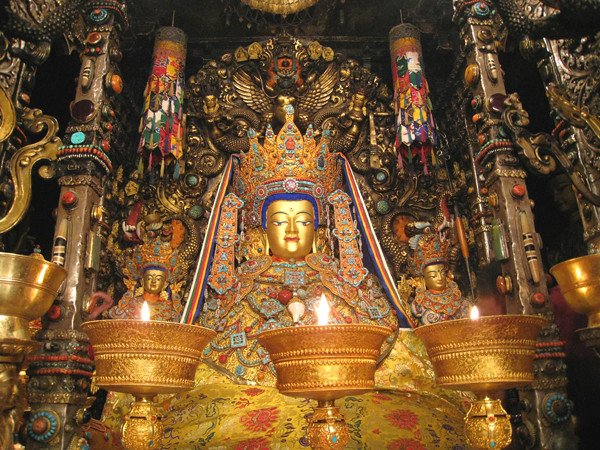Jowo Rinpoche, Jokhang Temple, Tibet
Yarlung Dynasty, Jowo Shakyamuni, 641, Jokhang Temple, Lhasa, Tibet.
In the sacred realm of Tibetan art, the Jowo Rinpoche stands as a testament to both the divine the human hands that have shaped its legacy over the span of 1300 years. This larger-than-life sculpture of Buddha Shakyamuni transcends mere material existence, for though crafted from gilt metal, its radiance evokes a golden hue that mirrors the ethereal nature of the divine. The juxtaposition of the Buddha's incredibly blue hair against the golden backdrop creates a celestial aura, drawing the beholder into a realm where the sacred and the sublime converge.
Seated in the lotus position, the Buddha's left hand forms the mudra of meditation, while the right extends in the profound gesture of "calling the earth to witness." In unison, these gestures encapsulate the transformative moment of the Buddha's enlightenment, frozen in time for eternity. When adorned, the Buddha wears a jeweled crown and robes that evoke a sense of divine regality, elevating the spiritual significance of this monumental figure.
The Jowo Rinpoche's journey through time is one of restoration and reconstruction, a testament to its enduring religious and cultural importance. While the exact nature of the changes it has undergone remains unknown, ancient texts hint that its current form may closely resemble its original. This continual renewal echoes the spiritual vitality it holds for the people of Tibet, who see it as more than a statue but a living proxy for the departed Buddha.
At the core of its significance lies the belief that the Jowo Rinpoche was carved by the celestial architect Viswakarma during the Buddha Shakyamuni's lifetime. Acting as a divine emissary, this statue serves as a conduit between the earthly realm and the spiritual domain, embodying a profound sense of continuity and connection.
Historical narratives interweave with the sacred aura of the Jowo Rinpoche, attributing its arrival in Tibet to Princess Wencheng Gongzhu. Her marriage dowry to Emperor Songster Gampo in 641 carried this celestial sculpture, marking a pivotal moment in the foundation of Buddhism in Tibet. While it may not be the earliest portrait of the Buddha, the Jowo Rinpoche transcends its temporal origins, resonating with cultural significance that spans across centuries.
To venerate the Jowo Rinpoche is to partake in a spiritual journey, where the celestial and the terrestrial converge. Its sublime presence, characterized by the delicate interplay of gold and blue, imparts a sense of otherworldly tranquility to those who stand in its sacred presence. In the hands of artisans and the embrace of the divine, this sculpture becomes not just a symbol but a living embodiment of the timeless connection between the mortal and the divine.
